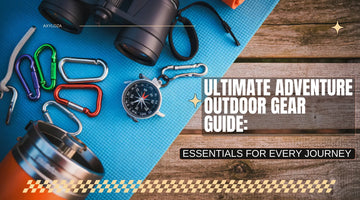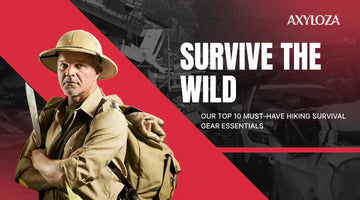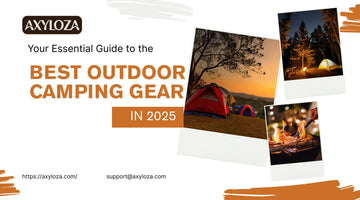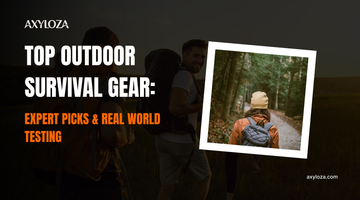Embarking on an outdoor adventure is one of life's greatest thrills. Whether you're summiting a peak, kayaking a serene river, or simply setting up camp under the stars, the right equipment is what transforms a challenging ordeal into an unforgettable experience.
This ultimate adventure outdoor gear guide is designed to be your comprehensive roadmap. We’ll walk you through the essentials for every journey, helping you build a versatile kit that prioritizes safety, comfort, and performance.
Why Having the Right Outdoor Gear Matters?
The difference between a good adventure and a bad one often comes down to your gear. The right adventure outdoor gear isn't about having the most expensive brands; it's about having reliable, appropriate equipment that protects you from the elements, keeps you safe, and allows you to focus on the experience. Inadequate gear can lead to discomfort, injury, or even dangerous situations. Investing in quality adventure gear is an investment in your safety and enjoyment.
The Core Categories of Adventure Gear
A well-prepared adventurer has a kit organized into logical systems. Think of these as the building blocks of your outdoor adventure gear collection.

Navigation & Safety Essentials
Even on well-marked trails, conditions can change. Never rely solely on your phone.
- Primary Navigation: A topographic map and a reliable compass are non-negotiable. Know how to use them
- Backup Navigation: A GPS device or a navigation app on a fully charged phone (with a power bank) is a great secondary tool.
- Safety Fundamentals: A whistle, a basic first-aid kit, and a multi-tool are absolute essential items. For remote trips, consider a personal locator beacon (PLB) or satellite messenger.
Shelter, Sleep & Emergency Comfort
Your shelter is your sanctuary. Your choice will depend on the trip, but preparedness is key.
- Shelter: A lightweight tent, hammock, or tarp protects you from wind, rain, and insects.
- Sleep System: A sleeping bag rated for the expected temperatures and an insulated sleeping pad are crucial for a restorative night's sleep. This is a core part of any outdoor camping gear list.
- Emergency Backup: Always carry an emergency space blanket or tarp. It’s lightweight and can be a lifesaver.
Hydration & Nutrition Tools
Staying fueled and hydrated is paramount.
- Water Purification: Never assume water is safe to drink. A filter, purification tablets, or a UV sterilizer should be standard in your outdoor survival gear.
- Water Storage: Use durable water bottles or a hydration reservoir.
- Cooking: A compact backpacking stove and fuel canister allow you to prepare hot meals and drinks. A simple pot and a spork are all you need for most meals.
Clothing & Layering Systems
The secret to comfort in changing conditions is layering. This is especially important when selecting outdoor gear for men and women, as the principle remains the same.
- Base Layer: Worn next to skin, this layer should wick moisture away (think soft wool or synthetic fabrics).
- Insulating Layer: This mid-layer traps heat (e.g., a fleece or down jacket).
- Outer Shell: A waterproof and windproof jacket and pants protect you from the elements.
Lighting & Power
When the sun sets, your adventure doesn't have to.
- Lighting: A headlamp is essential for hands-free operation. Always carry extra batteries.
- Power: A high-capacity power bank will keep your phone, GPS, or headlamp charged. Solar chargers are a great option for multi-day trips.
Specialized & Multi-Purpose Tools
Beyond the basics, a few key items add versatility.
- Multi-Tool: A good knife or multi-tool is essential for repairs, food prep, and countless unexpected tasks.
- Repair Kit: Include duct tape, cordage, and a few safety pins for quick fixes to gear.
- Sun Protection: Sunglasses, sunscreen, and a hat are vital at high altitudes or on water.
Adventure-Specific Gear Add-Ons
While the core categories are universal, specific activities demand specialized equipment. Here’s a quick look at how to adapt your best outdoor gear checklist.
- Hiking: Focus on a well-fitted backpack (daypack or multi-day), sturdy, broken-in hiking boots, and trekking poles to reduce joint impact.
- Climbing: Outdoor climbing gear is highly specialized and includes a harness, helmet, ropes, carabiners, belay devices, and climbing shoes. Never climb without proper training.
- Water-based adventures: For kayaking, canoeing, or rafting, a Personal Flotation Device (PFD) is the critical piece of adventure riding gear. Also consider dry bags, a bilge pump, and a waterproof case for your phone.
How to Build a Flexible Adventure Gear Kit?

Start with the core essentials listed above. This is your foundation. Then, add adventure-specific gear add-ons based on your planned activity. The goal is to have a modular system. For example, your core sleep system (bag, pad) can be used for backpacking, car camping, or even a spontaneous night under the stars.
Packing Smart — Organization Tips
Keep your gear accessible and your pack balanced.
- Use stuff sacks or packing cubes to group items (e.g., kitchen kit, sleep system, first-aid).
- Place heavy items close to your back and in the middle of your pack.
- Keep essentials like rain gear, a headlamp, snacks, and a first-aid kit in easily accessible pockets.
Maintenance & Longevity of Your Gear
Your top-rated outdoor gear is an investment. Protect it.
- Clean It: Follow manufacturer instructions to clean tents, sleeping bags, and technical apparel.
- Dry It: Always store gear completely dry to prevent mold and mildew.
- Store It Properly: Store sleeping bags and insulated jackets loosely, not compressed. Keep tents in a cool, dry place.
Final Thought
Building your perfect adventuring gear kit is a personal and rewarding process. It’s about finding the right balance between weight, functionality, and comfort for the journeys you love most. Remember, the best gear is the gear that gets you outside safely and confidently.
Ready to start assembling your own kit? For a curated selection of reliable and top-rated outdoor gear, explore the collection at Axyloza. Find everything you need to prepare for your next great adventure.
FAQs
What gear do you need for an outdoor adventure?
At a minimum, you need the Ten Essentials: Navigation, Headlamp, Sun Protection, First-Aid, Knife, Fire Starter, Emergency Shelter, Extra Food, Extra Water, and Extra Clothes. This guide expands on that foundational list.
What are the absolute essential items for any adventure?
The non-negotiable essential items are a way to navigate (map/compass), a way to purify water, a way to create shelter (tent/tarp), insulation (sleeping bag/layers), a first-aid kit, and a headlamp.
What's the best way to choose layers for outdoor adventures?
Follow the three-layer system: a moisture-wicking base layer, an insulating mid-layer, and a weather-protective outer shell. Choose materials based on the climate (e.g., wool for cold, synthetics for high-output activities).
Can you rely on a backpacking stove for cooking every type of meal?
Most backpacking stoves are excellent for boiling water, which is perfect for dehydrated meals, pasta, and drinks. They are less ideal for precise cooking like simmering or frying. Choose simple, one-pot meals for the best results.
How to choose between a daypack and a multi-day backpack?
A daypack (20-35 liters) is for short trips where you carry only daily essentials. A multi-day backpack (50-80+ liters) is designed to carry your shelter, sleep system, food, and all other gear for an overnight or longer expedition.
How to keep gear dry during rain or water activities?
Use a pack cover and line the inside of your backpack with a heavy-duty trash compactor bag or a dedicated pack liner. For items like electronics and sleeping bags, use individual dry bags or zip-lock bags.




